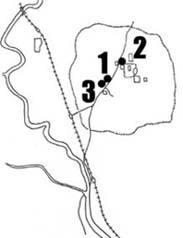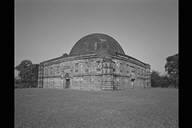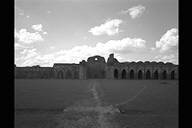
@1.EKLAKHI TOMB (c.1431)
@2.ADINA MASJID (1364-74)
@3.QUTB SHAHI MASJID (1582)
PANDUA
@
 |
@Fakhr ad-Din, who
established a new independent government, the Ilyas Shah
Dynasty, in Bengal and constructed a new capital in 1338
then transferred the capital from Gaur to Pandua. Muslims
called this new capital Firozabad. This transfer of the
capital can be traced by roads of 4 metres in width,
paved by bricks and stone materials from Hindu temples in
Gaur. Under the same dynasty, huge Adina Masjid was built
as a Jama Masjid. However, the Ilyas Shah Dynasty moved
its capital to Gaur again in 1420 and Pandua became one
of local cities of East Bengal. (Naoko Fukami) @1.EKLAKHI TOMB (c.1431) @2.ADINA MASJID (1364-74) @3.QUTB SHAHI MASJID (1582) |
@
 |
@It is considered to
be a tomb for sultan Jalal ad-Din (d. 1431), son of a
Hindu king, Raja Ghanesh, who converted to Islam. This
brick tomb with a magnificent dome is very similar to
Chika Masjid, which still exists in Gaur. It is situated
near Qutb Shahid Masjid and dargah of Nur Qutb Alam. By
the outside walls, niches and statues and delicate
patterns on pillars at the four corners, it is assumed
that it was built by Hindu masons. Inside the tomb is
octagon-shaped with each side having arches. There still
exist three mausoleums of the king, his wife and child.
(Matsuo Ara) @¨Plan and photos of each part |
| £Viewing from the southeast | |
@
@
 |
@It is considered to
be a tomb for sultan Jalal ad-Din (d. 1431), son of a
Hindu king, Raja Ghanesh, who converted to Islam. This
brick tomb with a magnificent dome is very similar to
Chika Masjid, which still exists in Gaur. It is situated
near Qutb Shahid Masjid and dargah of Nur Qutb Alam. By
the outside walls, niches and statues and delicate
patterns on pillars at the four corners, it is assumed
that it was built by Hindu masons. Inside the tomb is
octagon-shaped with each side having arches. There still
exist three mausoleums of the king, his wife and child.
(Matsuo Ara) @¨Detailed Explanation @¨Plan and photos of each part |
| £Viewing the iwan from the courtyard@@@@ | |
@
@
@